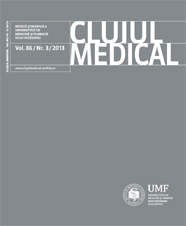The Role And Prognostic Impact Of Lymph Node Ratio On Stage III Colorectal Cancer
Keywords:
colorectal cancer, lymph node, prognostic factor, stagingAbstract
Aim. The aim of this study was to evaluate the prognostic significance of the lymph node ratio (LNR) in patients with stage III colorectal cancer.
Materials and Methods. We included 35 stage III colorectal cancer patients who underwent a curative resection at the County Clinic Hospital, Cluj-Napoca, 5th Surgical Clinic between January 2006-July2008. Patients were categorized into LNR groups 1 to 5 according to cut-off points: <0.1; 0.21; 0.36; 0.6; >0.61. The Kaplan-Meier and the Cox proportional hazard models were used to evaluate the prognostic effect according to the LNR.
Results. From one hundred forty-eight patients who underwent colorectal cancer resection, 33.1 % were stage III and 35 patients met the study inclusion criteria. The five-year survival rate in N1 group was 64.62% compared to the N2 group, where it was 8.57% (p<0.001) The lymph node ratio (LNR) groups consisted of 5 cases (14.2%) in LNR1 group (<0.1), five-year survival rate 100%, 6 cases (17.14%) in LNR2 group (0.11-0.21), five-year survival rate 83.33%, 8 cases (22.8%) in LNR3 group (0.22-0.36), five-year survival rate 37.5%, 12 cases (34.28%) in LNR4 group (0.37-0.60), survival rate 0%, and LNR5 group (>0.6). The relationship between the five-year survival rates in the five LNR groups results in a statistically significant proportionality (p<0.001).
Conclusion. Lymph node ratio can be considered a more accurate and potent modality for prognosis in stage III colorectal cancer and may improve stratification in this heterogenous group of patients.
Downloads
Published
How to Cite
Issue
Section
License
The authors are required to transfer the copyright of the published paper to the journal. This is done by agreeing to sign the Copyright Assignment Form. Whenever the case, authors are also required to send permissions to reproduce material (such as illustrations) from the copyright holder.

The papers published in the journal are licensed under a Creative Commons Attribution-NonCommercial-NoDerivatives 4.0 International License.

